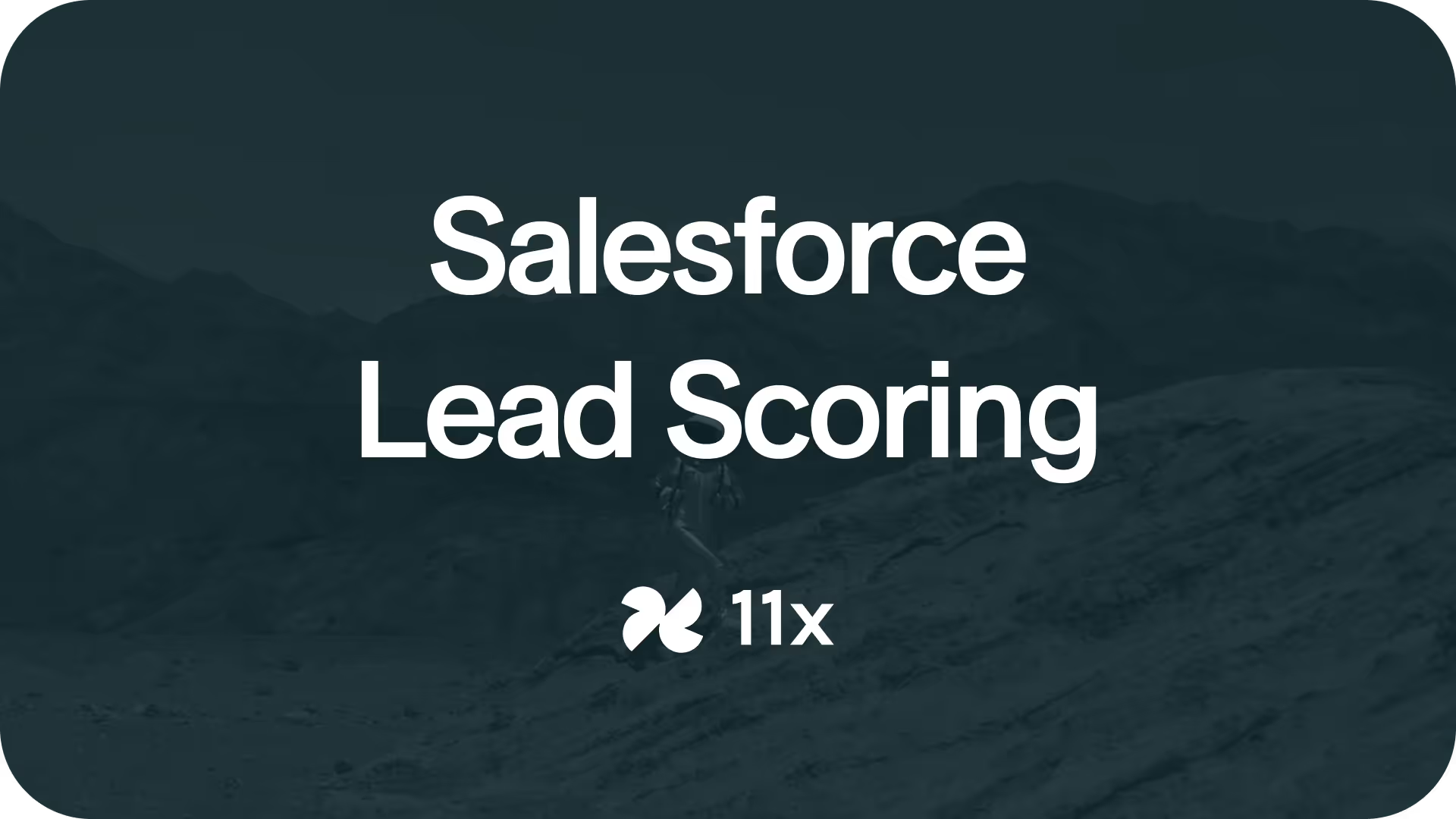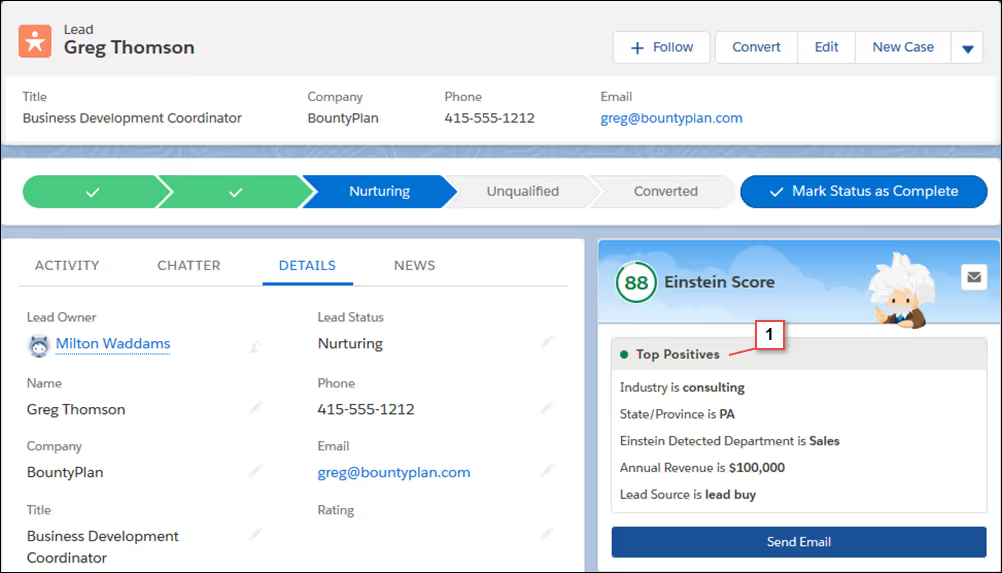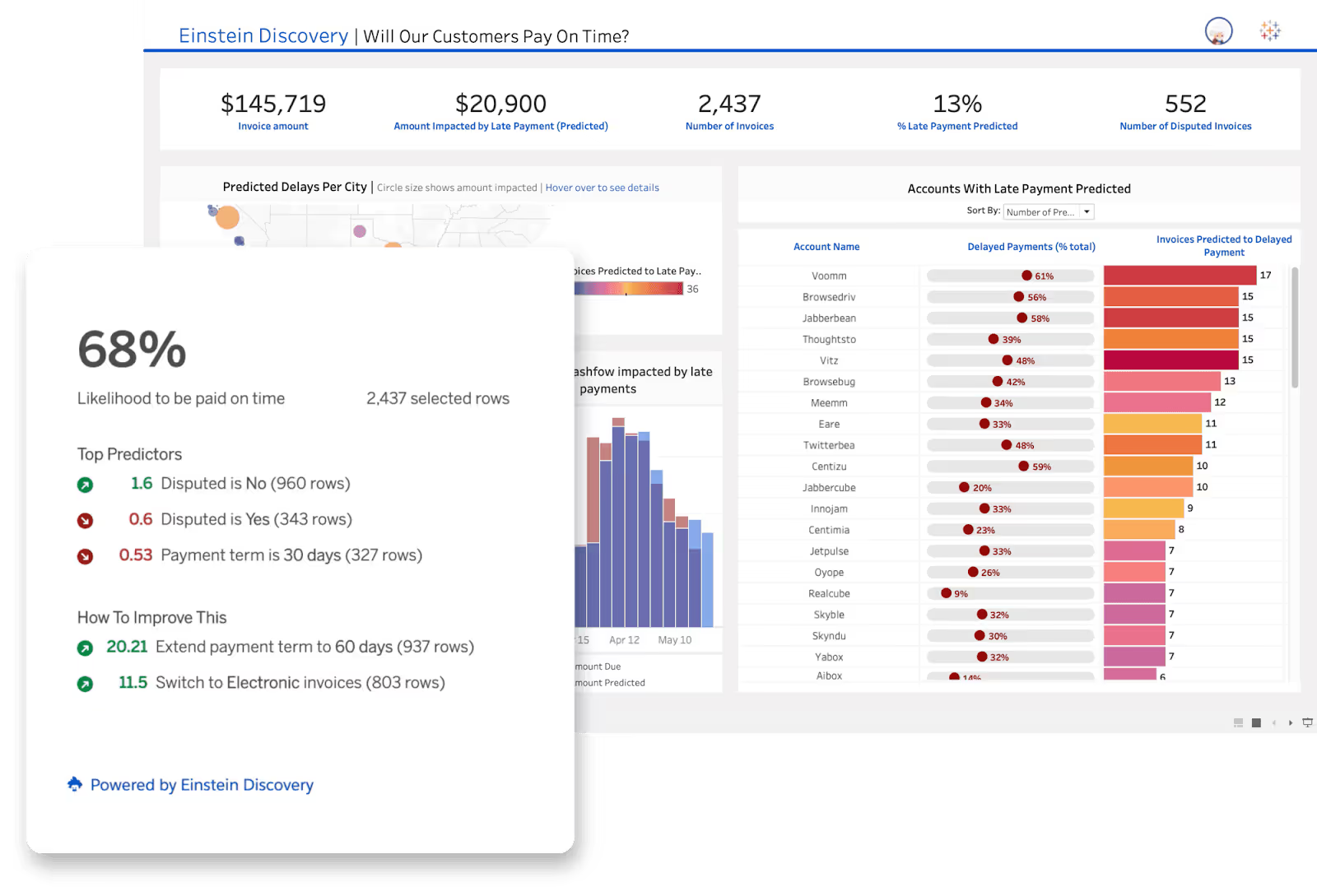How to Build, Automate, and Refine a Salesforce Lead Scoring Model

Sales teams lose hours on leads that were never going to convert. Volume fills the funnel, but intent stays blurred. Without clear differentiation between real buyers and casual browsers, your reps waste time on cold calls while high-intent opportunities go untouched.
Predictive lead scoring fixes that signal gap. For enterprise teams running on Salesforce, Einstein Lead Scoring applies machine learning to forecast conversion likelihood—but its accuracy is limited by the data it sees. When all your signals are internal, the model can’t fully distinguish interest from intent.
11x closes that gap. Our digital workers source qualified leads from 21+ premium intent and contact data providers, identify high-intent prospects automatically, and push them into your Salesforce instance in real time. Your scoring model runs on the richest set of buying signals, your reps work hotter pipelines, and conversion speed compounds.
This guide walks you through building, automating, and refining Salesforce lead scoring that actually predicts revenue outcomes.
What Is Lead Scoring in Salesforce?
Lead scoring assigns numerical values to prospects based on two main dimensions: fit and behavior.
Fit attributes:
- Job title and seniority level
- Company size and revenue
- Industry alignment with your ICP (ideal customer profile)
- Geographic location or market segment
Behavioral signals:
- Email engagement, such as opens and clicks
- Website visits and time spent on key pages
- Webinar registrations or attendance
- White paper or content downloads
- Product demo requests or trial activations
Together, these dimensions combine to show both who the lead is and how actively they are engaging, giving your scoring model a balanced view of intent and potential fit.
Salesforce operationalizes this through Einstein Lead Scoring, a built-in predictive model that analyzes historical conversion data using machine learning algorithms. The system learns which combination of attributes and behaviors correlate with closed deals, then applies these patterns to rank new leads on a 0–100 scale.
The Einstein Score appears directly within lead records in Sales Cloud, giving sales reps immediate visibility into conversion probabilities. Marketing teams using Marketing Cloud can also access these scores to refine campaigns and improve the quality of lead generation and MQL-to-SQL handoff.
This shared visibility creates a unified funnel view where both teams operate from common conversion metrics instead of competing narratives about lead quality.
Why Lead Scoring Matters for Salesforce Users
Effective lead scoring systems transform your CRM from a static record keeper into a live, predictive growth engine. Sales reps can instantly identify which types of leads show the most purchase intent, improving conversion efficiency and overall revenue velocity.
Alignment between marketing teams and sales teams strengthens decision-making around campaign targeting, qualification criteria, and pipeline prioritization. Automated workflows instantly route high-scoring prospects, ensuring no hot lead sits idle. Lower-scoring contacts enter nurture sequences, improving long-term conversion while maintaining data hygiene.
Accurate scores drive better forecasting. When your scoring model predicts conversion with precision, decision-making becomes data-driven, not instinctive. Managers allocate outreach capacity efficiently, and marketing adjusts budget allocations based on measurable performance improvements.
Ultimately, lead scoring brings accountability and clarity. Teams can see which attributes drive higher scores and which activities move the needle most for conversion rates, to optimize pipeline operations over time.
How to Set Up Lead Scoring in Salesforce
Step 1: Enable Einstein Lead Scoring
In Setup, search for “Einstein Lead Scoring” and enable it for relevant profiles. Ensure your CRM contains enough conversion data for model training. Einstein automatically maps correlations between successful deals and attributes such as job title, company size, or account engagement recency.

Step 2: Review and Customize the Predictive Model
Once training completes, open the Einstein Lead Scoring dashboard to review key predictors. You’ll see which attributes drive conversions, such as demo requests, form fills, or pricing-page visits, and which reduce them, like unsubscribes or inactivity.
Check whether these predictors match your real conversion patterns. If certain titles, industries, or regions look misaligned, the issue usually stems from incomplete or outdated CRM data. Start by cleaning and enriching those records, then retrain Einstein so the new data recalibrates the weight of each variable.
Regular retraining is essential. Run it whenever new campaigns, products, or buyer behaviors shift your funnel. This ongoing review keeps your model current, accurate, and grounded in the way your best customers actually buy.

Step 3: Add and Display the Einstein Score Field
Place the Einstein Score field prominently in your lead layout. Visibility encourages reps to act faster on high-intent prospects. Example interpretation bands:
- 80–100: hot leads, ready for immediate outreach
- 50–79: warm leads, ideal for nurturing
- Below 50: cold leads needing enrichment or requalification
[Screenshot: Einstein Score field on lead record - place here]
Step 4: Build Lead Scoring Reports and Dashboards
Create dashboards to track the number of leads in each score band and analyze conversion rates per segment. Report on account engagement, source quality, and sales funnel velocity. Over time, you’ll identify patterns by types of leads, industries, or campaigns that deliver higher performance.
Step 5: Automate Routing and Workflows by Score
Use Flow or Process Builder to route qualified leads automatically. For example, if the Einstein Score exceeds 75, assign the lead to a senior representative. Scores between 50 and 74 might trigger a marketing automation campaign. Leads scoring below 50 can be sent into an automated data enrichment process that fills in missing firmographic or contact details, verifies accuracy, and adds fresh intent signals before the lead is rescored. These automations remove manual sorting, improve data quality, and speed up every follow‑up cycle.
Optimizing Your Scoring Model for Better Accuracy
A strong scoring model depends on three fundamentals: balanced inputs, consistent validation, and current data. Breaking that down:
1. Balance firmographic and behavioral inputs
Effective models combine who the lead is with how they behave. Firmographic data includes company size, industry, and role alignment with your ideal customer profile. Behavioral signals reflect activity such as email opens, webinar attendance, or website visits. Relying only on behavior can create false positives because high engagement does not always mean a buying intent. The objective is to weight both categories so that fit and activity carry equal influence in the final score.
2. Apply negative and decay rules
Not every signal adds value. Deduct points for inactivity, bounced emails, or unsubscribes. Apply time-based decay rules that gradually lower scores when there has been no engagement for a specific period. This process keeps prioritization accurate and ensures the model reflects current interest, not outdated interactions.
3. Validate scoring accuracy with conversion data
Regularly review closed-won ratios for each scoring bracket to test whether scores actually match conversion likelihood. If low-scoring leads close at similar rates to high-scoring ones, the scoring weights need adjustment. Periodic retraining helps Einstein stay aligned with seasonal changes, regional differences, and updates in your product mix.
4. Integrate behavioral signals across systems
Include engagement data from every connected platform such as your marketing automation system, webinar tools, and social channels so Salesforce becomes the single source of truth. The more complete the data, the more accurately Einstein can model conversion probability.
5. Maintain data freshness
Even the best algorithm fails when fed outdated information. Continuously synchronize and enrich lead data so firmographics, intent indicators, and contact details remain current. The fresher the data, the more reliable your scoring predictions will be.
How 11x Enhances Salesforce Lead Scoring and Qualification
Traditional lead scoring systems focus on interpreting what is already in the CRM, which often lags behind current buying intent. 11x closes that gap by feeding Salesforce with live, high-quality data from more than twenty premium sources that include firmographics, technographics, funding events, job changes, and verified intent signals. This continuous enrichment ensures your scoring models are powered by current market activity instead of outdated records.
What separates 11x from other systems is that it does more than enrich data. Its digital workers act on it. Julian manages inbound conversations and qualification so every active lead receives immediate attention, while Alice runs multi‑channel outreach across email, voice, and social to engage prospects continuously. As these campaigns operate, all interactions flow back into Salesforce in real time, allowing Einstein Lead Scoring to learn from the most recent activity and adjust conversion probabilities automatically.
11x proves especially valuable for leads in lower or mid‑score ranges that would otherwise sit ignored in the CRM. The system reengages these contacts through tailored follow‑ups, identifying which show renewed buying intent and surfacing them for your sales team. For high‑scoring leads, Alice amplifies pipeline velocity by executing personalized campaigns that move them quickly toward conversion.
For SaaS companies and larger B2B teams, this coordinated blend of enrichment, scoring, and automatic engagement turns Salesforce into an active growth engine. 11x keeps every lead in motion, transforming predictive models into a closed feedback system that generates consistent, qualified opportunities and measurable revenue impact.
Common Mistakes to Avoid in Salesforce Lead Scoring
Even the smartest lead scoring system can underperform if built on weak data or misaligned processes. Avoid these common pitfalls to keep your Einstein Lead Scoring model accurate, adaptive, and revenue-impacting.
- Overloading your model with noise: Adding too many irrelevant fields overwhelms the model. Stick to attributes that strongly correlate with closed-won deals. Poor data hygiene creates false positives and weak predictions.
- Letting models drift: Einstein’s accuracy declines when models aren’t retrained. Recalibrate every 60 days as new conversions update your CRM. Adjust inputs to match your active ICP and campaign cycles.
- Ignoring external enrichment: Internal CRM data shows engagement, not intent. Connect external providers like 11x to feed real buying signals into Salesforce and reveal the leads that actually matter.
- Neglecting lead alerts: Without automated notifications, high-scoring leads can languish. Trigger real-time alerts when Einstein Scores spike so reps can act fast and protect pipeline velocity.
Consistent tuning, clean data, and external signal integration keep lead scoring from becoming another static dashboard and turn it into a living system that accelerates conversion.
Predict, Enrich, and Engage
Salesforce turns lead scoring into data science through Einstein’s predictive lead scoring algorithms. But prediction alone isn’t enough. 11x completes the loop by curating intent data, automating lead generation, and maintaining consistent account engagement so your team never loses momentum.
Together, they convert lead scoring systems into living pipelines that adapt automatically as markets shift. The result is a fully autonomous sales funnel where every contact is enriched, scored, and engaged in real time.
See how 11x connects qualified leads directly into Salesforce and turns your scoring model into a live, data-driven source of revenue insight.
Frequently Asked Questions
Salesforce lead scoring is the method Salesforce uses to calculate how likely a prospect is to become a customer. It applies a numeric ranking to each lead based on measurable signals of fit and intent so that sales teams can focus on the accounts most likely to close. The system uses two sets of inputs: firmographic attributes such as company size, revenue, and industry, and behavioral signals like email engagement, content consumption, and meeting requests. Einstein Lead Scoring builds on this foundation by training a data model from your organization’s historical conversion results. It learns which factors consistently appear in deals that close and applies those same patterns to all new and existing leads. This allows your team to see, inside the CRM, which prospects are most aligned with your ideal customer profile and which may need further nurturing.
Einstein works by analyzing every past lead that became an opportunity or closed-won deal in your Salesforce instance and comparing them to those that did not. It searches for statistical correlations between lead attributes, engagement history, and conversion outcomes. Once identified, those correlations become weighted inputs in a predictive model that assigns each new record a score from 0 to 100. Each score represents the probability of conversion, not a simple point total. The model updates automatically as your pipeline changes, meaning new customer data and campaign results constantly influence its predictions. Admins can view the specific factors influencing scores inside the Einstein dashboard, allowing teams to understand why high-quality leads share common patterns. This process replaces guesswork with a transparent, evidence-based method for prioritizing outreach.
The scoring model incorporates a variety of measurable factors. Fit criteria include job title, management level, company size, annual revenue, and industry. Engagement inputs track the recency and frequency of activity such as email opens, meeting attendance, pricing-page visits, chatbot interactions, or white paper downloads. Negative data points, such as bounced emails or long periods without responses, typically lower a lead’s probability. Salesforce also allows connection of outside data sources to improve accuracy. For instance, integrating marketing platforms or intent data vendors adds indicators such as keyword research activity, event participation, or competitor tool usage. Together, these features ensure that leads are ranked according to both who they are and how they behave inside the buying journey.
Yes. Once Einstein Lead Scoring is active, Salesforce automatically evaluates every lead record at the moment of creation or when new information is added. There is no manual calculation required. Administrators can set rules to trigger actions based on score thresholds. A lead scoring above 75 might be routed immediately to a senior sales rep, while lower scores can be enrolled in nurturing campaigns for long-term follow-up. Automation tools such as Flow or Process Builder handle these steps, ensuring speed and consistency. Because Einstein retrains its predictive model whenever new conversion data accumulates, the scoring process continuously improves without periodic manual rebuilding. This approach keeps qualification consistent at scale and reduces response latency across the funnel.
11x strengthens Salesforce lead scoring by improving the completeness and accuracy of the data that Einstein relies on. Most scoring models depend solely on internal CRM data, which often lacks depth, freshness, and context. 11x supplements that data with verified inputs from more than twenty premium external sources that include firmographic details, technology usage, recent funding rounds, hiring trends, and real buying intent signals from the market. These constant updates provide a broader and more current base for Einstein’s predictive models to analyze. In addition, 11x automates the collection and synchronization of that data so Salesforce always reflects the latest information without manual imports or enrichment cycles. The result is a cleaner, continuously updated dataset that allows lead scores to reflect real conditions in the market rather than static or incomplete records.


.png)
.png)
.png)
.png)
.png)
